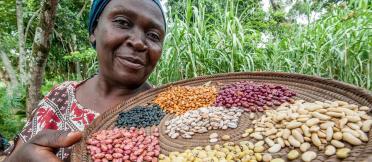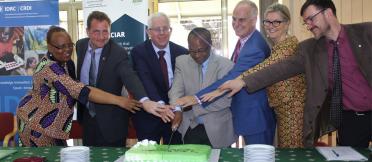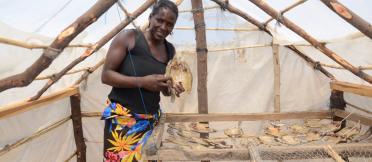- HomeHome
-
About ACIAR
- Our work
- Our people
-
Corporate information
- ACIAR Audit Committee
- Commission for International Agricultural Research
- Policy Advisory Council
- Agency reviews
- Executive remuneration disclosure
- Freedom of information (FOI)
- Gifts and benefits register
- Information publication scheme
- List of new agency files
- Contracts
- Legal services expenditure
- Privacy impact assessment register
- Commonwealth Child Safe Framework
- Benefits to Australia
- Careers
- 40 years of ACIAR
-
What we do
- Programs
- Cross-cutting areas
- Resources
- Where we work
-
Funding
- Research projects
- Fellowships
-
Scholarships
- John Allwright FellowshipScholarships to study in Australia for ACIAR partner country scientists to have Australian postgraduate qualifications
- ACIAR Pacific Agriculture Scholarships and Support and Climate Resilience Program
- Alumni Research Support Facility
- Publications
- News and Outreach
Date released
16 December 2020
High risk, highly innovative projects that could deliver breakthrough results to improve food security, resilience and gender equality are the focus of a joint partnership between ACIAR and Canada’s International Development Research Centre (IDRC), to support farmers across eastern and southern Africa.
More than 70% of the rural population in this region rely on agriculture for their livelihoods, but poor performance in the sector and multiple threats, such as drought, limit their ability to consistently produce enough nutritious food to feed themselves and their communities every year. The threats are not all new, but new ways to address them are needed that have a greater impact and longer-lasting results for smallholder agricultural producers.
In response to these challenges, the ten-year, A$37 million Cultivate Africa’s Future Fund (CultiAF) was established in 2013 to leverage the strengths and resources of both ACIAR and IDRC to improve food security in the region. Now in its second phase, CultiAF-2 will boost efforts by the two development research agencies to use innovative science to build resilience to major food systems risks in the region, including drought.
Seeds sown in drought
Drought is a killer in Africa, affecting crops, livestock and people. One of the most devastating disasters to hit the region occurred in 2011–12 when some 13 million people were forced to subsist on urgent humanitarian assistance following the drought-induced Horn of Africa food crisis. A year later, CultiAF was created.
Dr Renaud De Plaen, the program leader for IDRC’s Agriculture and Food Security program, says the partnership with ACIAR came at a fortuitous time. Over the past 50 years, IDRC has engaged in a broad range of research, from agriculture to education, but in 2010 IDRC decided to renew its focus on agriculture and food security as one of its core pillars. In line with this shift, IDRC and the Government of Canada formed the CA$100 million International Food Security Research Fund to improve food security in the Global South. The fund’s model formed the basis on which CultiAF was soon after built.
‘This was a program designed with the idea that by working together, IDRC and ACIAR would not only leverage their respected financial resources into programming in the region but would also really engage in a partnership. This would capitalise on their respective experiences [and] their networks in the region, helping to bring greater relevance, visibility and uptake of the research,’ says Dr De Plaen.
At first glance, CultiAF might not seem like the most obvious endeavour for ACIAR and IDRC to embark on. After all, Australia and Canada are not big players in the African development landscape, which is dominated by government support from European countries and the USA. But what makes IDRC and ACIAR stand out is their shared focus on research for development. In fact, ACIAR was modelled after IDRC and a lot of Australian science is incredibly relevant in Africa because of the shared similarities with Australia such as climatic zones, says Chief Executive Officer of ACIAR Professor Andrew Campbell. ‘Expertise in dryland systems, managing climate variability and designing irrigation systems for dry areas: they’re all relevant to both Africa and Australia,’ he adds.
The ACIAR-IDRC partnership is not only strategic, it’s also efficient. IDRC has more staff in Africa so leads operational management on the ground in consultation with ACIAR. This symbiotic relationship is working out so well that it has the potential to shape the way IDRC and ACIAR work in other regions. ‘We’re looking at further investments in South-East Asia where we do it the other way around—where ACIAR would manage the projects on behalf of IDRC,’ says Professor Campbell. ‘This is a very welcome development that two donors have sufficient trust to have the other manage their funds. This allows us to work together instead of having two layers, two separate lots of administration and all the duplication that involves.’
Part of what has enabled such a natural working relationship between IDRC and ACIAR is that the two donor agencies ‘completely align’ on key priorities, such as gender and climate change. ‘It’s very easy to co-invest when you have the same priorities,’ says Professor Campbell.
Investing locally
Within the African context, CultiAF’s approach differs from that of many other portfolios because its projects are led by a local partner and not by an international agency. ‘That means we’re not just putting more money into the same international centres, we’re actually building local capability in local universities, national departments of agriculture and research institutes,’ says Professor Campbell. ‘If the international agencies want to contribute or be part of CultiAF projects, they have to collaborate with national partners. That has been very welcomed in Africa and it’s given some local researchers access to resources that they felt they didn’t have before.’
During its first phase, the program operated in five countries—Kenya, Malawi, Uganda, Zambia and Zimbabwe—implementing a total of eight projects. Collectively they focused on helping smallholder farmers reduce post-harvest losses; improve crop and livestock productivity through better water use; and improve nutrition. Dr De Plaen says they have seen ‘really interesting results’ generated through innovative business and industry development solutions that have delivered improved food security, more jobs and higher incomes.
In Malawi, introducing improved solar tent dryers to process fish resulted in an almost 70% reduction in fish losses, which translated to higher incomes for the processors and more fish for consumers. Meanwhile in Kenya, where fish and poultry feed are one of the key bottlenecks to increased protein production, using insects as a sustainable animal feed has reduced production costs. Rearing the insects also has the potential to create more than 40,000 jobs in Kenya alone. These jobs could be filled by unskilled workers and people without money to invest, which opens up opportunities for more women and young people to be employed who have may have had limited access to education and financial resources.
Expanding scope and impact
Building on these results, the second phase—known as CultiAF-2—has expanded to include Ethiopia and Mozambique resulting in a total of seven countries with nine projects. The ten-year program—spanning CultiAF and CultiAF-2—is due to conclude in 2023.
‘We’re really looking at strategic collaboration to bring more impact to each organisation’s respective work in eastern and southern Africa,’ says Dr De Plaen. This phase will focus on four key priorities: 1) improving productivity and incomes and reducing post-harvest losses; 2) advancing gender equality; 3) linking agriculture, nutrition and human health; and 4) managing climate change and water sustainability.
CultiAF-2’s priorities align with various individual country and regional policies, such as the African Union’s Comprehensive Africa Agriculture Developmental Programme. That’s because both programs aim to reduce post-harvest losses, increase agricultural output and create jobs for women and youth. Also, CultiAF-2’s mandate to focus on secondary ‘neglected’ crops in regions where millions of vulnerable people are food insecure complements major local initiatives, such as the Alliance for a Green Revolution in Africa and the Forum for Agriculture Research in Africa.
‘We try to engage multiple actors, including policy-makers and private-sector groups so that the innovations being developed can hopefully be scaled up by them throughout the continent,’ says Dr De Plaen.
This innovative approach to partnering, coupled with CultiAF’s investment in higher-risk but more innovative ideas, is the key to success. Both agencies expect the approach will continue delivering results for smallholder farmers and sow the seeds for ongoing innovation through building local research and development capacity.
More information
www.idrc.ca/en/initiative/cultivate-africas-future
Key points
- CultiAF is a 10-year A$37 million partnership between ACIAR and Canada’s International Development Research Centre.
- By investing in high-risk but highly innovative projects CultiAF aims to improve food and nutrition security, resilience, and gender equality across eastern and southern Africa.
- CultiAF projects are led and delivered by local partners and targeted at improving outcomes for smallholder agricultural producers.
Case study: A flying success
As part of a CultiAF project, innovative Kenyans are turning insects into business.
Fishmeal and soybean are commonly used by Kenyan farmers as essential protein sources for their livestock and fish. But both can be too expensive for small-scale farmers to afford.
By farming the black soldier fly (BSF), the entrepreneurs have found a cheaper and more reliable and sustainable way of producing the much-needed protein.
BSF as fresh livestock feed
Kenyan farmer Roseanne Mwangi first learnt how to derive chicken feed from the larvae of houseflies fed on pig manure while attending a conference in Uganda.
Ms Mwangi’s research then led her to BSF, which is neither a pest nor a vector for human disease transmission.
With support from the CultiAF INSFEED (Insect feed for poultry and fish production in sub Saharan Africa) project led by the International Centre of Insect Physiology and Ecology (ICIPE), Ms Mwangi started producing BSF in 2019. She now produces an average of 500 kg of live BSF larvae every week, which is fed directly to her chickens and pigs.
‘Within two months, our free range chickens weigh 800 grams and appear huge compared to kienveji chickens in the market,’ says Ms Mwangi.
‘When feeding the pigs with BSF, we have noticed that the pigs get to marketable size four to six weeks earlier, which in turn reduces the feeding and labour costs involved in pig production in my facility. We have also noted the significant reduction in fat, resulting in more lean meat production from the pigs.’
Dried and packaged BSF
Commercial production of BSF is also under way with 24-year-old Ms Talash Huijbers. On her InsectiPro farm in Kenya she is on a quest to source more sustainable protein feed solutions through insects.
Ms Huijbers started experimenting with crickets, which she now produces commercially for human food. In 2018 she looked to expand, with starter BSF stock supplied via ICIPE through the CultiAF INSFEED project.
‘Currently, we are at three tonnes daily production and eyeing to supply the larvae to large-scale feed enterprises in the region,’ says Ms Huijbers.
Ms Huijbers dries at least 70% of the larvae she produces, packaging it for sale as livestock feed. The remaining 30% is raised to become adult flies for continuity of the colony.
Both farmers demonstrate how research can be applied when in the hands of innovative business-minded people.
ACIAR PROJECT: Insect feed for poultry, fish and pig production in Sub-Saharan Africa (INSFEED2), GP/2019/171.
Ms Talash Huijbers has developed a business that is producing, drying and packaging black soldier fly larvae for use as livestock feed.
Photo: Emmie Wachira, ACIAR.
Key points
- CultiAF is investing in highly innovative work to explore the development of insect farming.
- Black soldier flies are proving a profitable business venture for farmers in Kenya.





